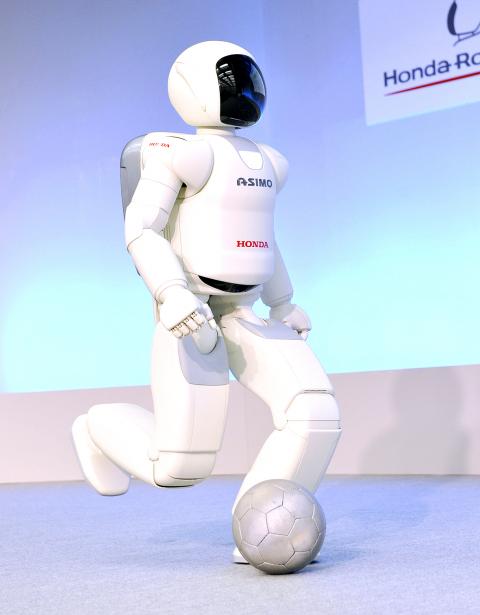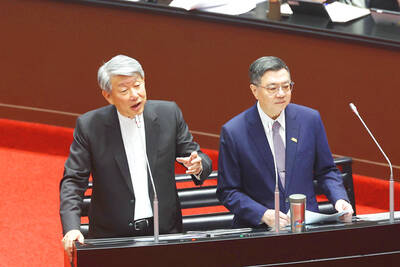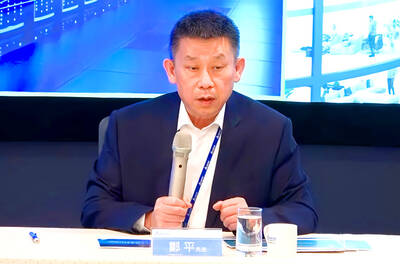Honda Motor Co’s human-shaped robot can now run faster, balance itself on uneven surfaces, hop on one foot and pour a drink. Some of its technology might even be used to help out with clean-up operations at the stricken Fukushima Dai-ichi nuclear power plant.
Honda’s demonstration of the revamped Asimo yesterday at its Tokyo suburban research facility was not only to prove that the bubble-headed childlike machine was more limber and a bit smarter.
It was a way to try to answer some critics that Asimo, first shown in 2000, had been of little practical use so far, proving to be nothing more than a glorified toy and cute showcase for the Honda brand.

Photo: AFP
Honda president Takanobu Ito told reporters some of Asimo’s technology was used to develop a robotic arm in just six months with the intention of helping with the nuclear crisis in northeastern Japan.
According to Honda, the mechanical arm can open and close valves at Fukushima plant, which went into meltdown after the March earthquake and tsunami. The automaker is working with the utility behind the problem plant, Tokyo Electric Power Co, to try to meet demands to bring the plant under control.
Ito acknowledged that the first idea was to send in Asimo to help out, but that was not possible because the robot cannot maneuver in rubble and its delicate computer parts would malfunction in radiation.
However, in yesterday’s demonstration, Asimo was able to walk without falling over 2cm padded bumps on the floor.
It can also now jog faster than it did in 2005, at 9kph, instead of the earlier 6kph, pushing better with its toes so its run was smoother and not as jerky.
Asimo was also able to distinguish the voices of three people spoken at once, using face recognition and analyzing sound, to figure out that one woman wanted hot coffee, another orange juice and still another milk tea.
The new Asimo got improved hands as well, allowing individual movement of each finger, so it could do sign language.
“My name is Asimo,” it said, making the signs of its words with stubby fingers.
It also opened a thermos bottle and gracefully poured juice into a paper cup.
Ito said Asimo had developed autonomous artificial intelligence so that it could potentially maneuver itself through crowds of people, without remote control or stopping each time to check on its programming.
However, he acknowledged that making robotics into a practical business will take more time, meaning Asimo is not about to show up in any home soon.
“Maybe at the start this was a dream of engineers to make a machine that was close to a human being, like Astro Boy,” he said. “We think Asimo is good.”
Other manufacturers are also developing robots, eager to cash in on the expected needs of Japan’s rapidly aging population.
Toyota Motor Corp, Japan’s top automaker, is among those to have jumped on the robotics bandwagon.
In the past, it has shown robots that can play the violin and talk like receptionists. Last week, it showed a computerized device that latches on to the body to help old or sick people walk and keep balance.
Honda has developed similar brace-like gadgets to help people get about.
Neither the Toyota nor Honda product is on sale yet.
Still, experts say such research is important to keep up.
“Maybe it can’t be put to use right away, but it is definitely a technology that we should keep working on to advance,” Hiroshi Kobayashi, a mechanical engineering professor at Tokyo University of Science, said of the new Asimo.
“It is common for what we achieve in research to turn out later to lead to many products,” said Kobayashi, who has developed experimental robots.

Taiwanese suppliers to Taiwan Semiconductor Manufacturing Co. (TSMC, 台積電) are expected to follow the contract chipmaker’s step to invest in the US, but their relocation may be seven to eight years away, Minister of Economic Affairs J.W. Kuo (郭智輝) said yesterday. When asked by opposition Chinese Nationalist Party (KMT) Legislator Niu Hsu-ting (牛煦庭) in the legislature about growing concerns that TSMC’s huge investments in the US will prompt its suppliers to follow suit, Kuo said based on the chipmaker’s current limited production volume, it is unlikely to lead its supply chain to go there for now. “Unless TSMC completes its planned six

Power supply and electronic components maker Delta Electronics Inc (台達電) yesterday said second-quarter revenue is expected to surpass the first quarter, which rose 30 percent year-on-year to NT$118.92 billion (US$3.71 billion). Revenue this quarter is likely to grow, as US clients have front-loaded orders ahead of US President Donald Trump’s planned tariffs on Taiwanese goods, Delta chairman Ping Cheng (鄭平) said at an earnings conference in Taipei, referring to the 90-day pause in tariff implementation Trump announced on April 9. While situations in the third and fourth quarters remain unclear, “We will not halt our long-term deployments and do not plan to

‘SHORT TERM’: The local currency would likely remain strong in the near term, driven by anticipated US trade pressure, capital inflows and expectations of a US Fed rate cut The US dollar is expected to fall below NT$30 in the near term, as traders anticipate increased pressure from Washington for Taiwan to allow the New Taiwan dollar to appreciate, Cathay United Bank (國泰世華銀行) chief economist Lin Chi-chao (林啟超) said. Following a sharp drop in the greenback against the NT dollar on Friday, Lin told the Central News Agency that the local currency is likely to remain strong in the short term, driven in part by market psychology surrounding anticipated US policy pressure. On Friday, the US dollar fell NT$0.953, or 3.07 percent, closing at NT$31.064 — its lowest level since Jan.

The New Taiwan dollar and Taiwanese stocks surged on signs that trade tensions between the world’s top two economies might start easing and as US tech earnings boosted the outlook of the nation’s semiconductor exports. The NT dollar strengthened as much as 3.8 percent versus the US dollar to 30.815, the biggest intraday gain since January 2011, closing at NT$31.064. The benchmark TAIEX jumped 2.73 percent to outperform the region’s equity gauges. Outlook for global trade improved after China said it is assessing possible trade talks with the US, providing a boost for the nation’s currency and shares. As the NT dollar